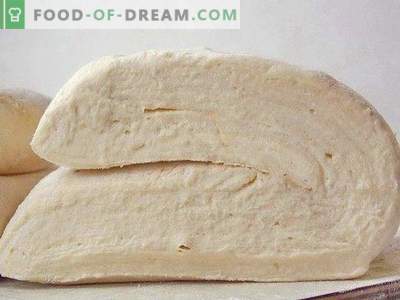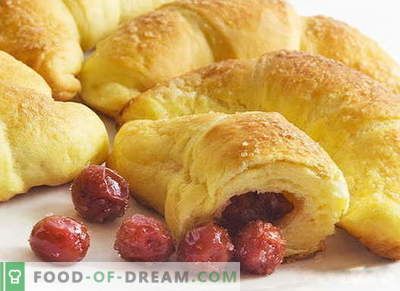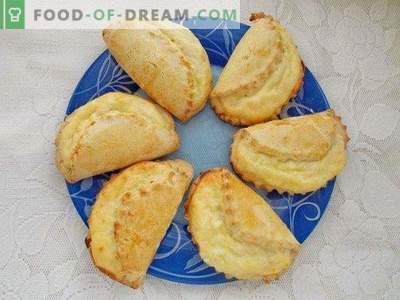
Bun in the shape of a bagel - the pride of French confectioners, is a pastry made of puff pastry, in which the filling is wrapped.
All the legends about the French croissants - nothing more than a beautiful fairy tale.
It does not matter who and when came up with the croissants.
The fact is that this type of baking has existed for a long time and not only in France, but also in other cuisines of the world.
The basis of croissants, puff pastry is a semi-finished product that is complicated in terms of the technique of manufacturing, but certainly worthy of attention. This type of dough was known to ancient Assyrian women: so the French pastry-makers, most likely, got a long-forgotten recipe, which they tried to make a legend. As you know, everything new is well forgotten old.
A variety of ways to make French croissants at home can significantly expand the range of these “morning cakes” for coffee precisely by making different types of dough, not to mention the fillings. By the way, the technology of the no less famous “fillo” dough has some similarities with the preparation of puff pastry, and, as you know, Eastern culture, like Eastern cuisine, generally has a more ancient history, rooted in the origins and origin of the Assyrian state.
You can buy pastries at the bakery or choose ready-made puff pastry at the nearest supermarket and cook croissants with your favorite stuffing yourself, reducing the time and effort required to prepare. Well, for those who are interested in the process itself, interesting and experimental variants of the puffs, let us dwell in detail on the technological aspects of the puff pastry.
How to make French croissants at home - basic technological principles
Layered dough requires some skills in its preparation, due to the nature of its technology. Therefore, the hostess or avoid it, or prefer to buy ready-made semi-finished product. But having mastered the rolling technology, who dared to try to prepare this type of dough on their own, housewives once and for all refuse the services of the culinary departments in favor of home quality and an amazing variety of recipes. The main technological aspects of puff pastry are the use of ingredients and a special method of its preparation. Layered dough is called precisely because it is kneaded in a special way: the dough is not simply mixed in containers, but rolled and rolled up, as if rubbing fat into flour. When baking dough between layers, an air gap is formed, due to the interaction of fat with gluten-free flour. Ductile gluten retains the air inside the dough, making the product fluffy and layered. This way of making dough requires certain practical skills.
Dough for croissants is prepared in two ways: “as in a bakery shop” and “as in a pastry shop”. In the first case - puff yeast dough, and in the second version, it is prepared without using yeast. But both types are mixed in the same way - rolling.
By the way, the fillo dough is prepared without yeast, but not by rolling, but by stretching. This type of dough, which is considered a classic in the Middle East, contains less fat and has a drier and more fragile structure.
Directly for the preparation of croissants, three methods of dough preparation are applicable:
French way: dough wrapped in fat;
German way: fat is wrapped in dough;
Dutch way: spread the fat on the dough.
All three ways, to be honest, have a purely technical difference, with the presence of elements of competitive spirit between bakers and confectioners of the respective European kitchens. From a practical point of view, the Dutch method is most convenient, with some reservations: it is very difficult to roll evenly pieces of fat in order to obtain a uniform dough structure. Therefore, it is better to pre-freeze the fat and grate it. Without waiting for the fat to melt, spray it with a small amount of flour and freeze again. It is better to take out the fat prepared in this way in parts, to prevent it from melting, and to use for each layer, as necessary.
What is difficult to disagree with competing professionals of European cuisine, is that fat for puff pastry should be only the highest grade: it is better if not margarine, and butter with a fat content of 82.5%. By the way, the French, Germans and the Dutch on this item show a rare consensus. The same unanimity manifests itself in the requirements for the quality of flour, yeast, if we are talking about bakery products. In industrial production, in order to save and maximize profits for puff pastry and, in particular, croissants, margarine or vegetable fats are used. This is not to say that this ingredient is not allowed, because each method and recipe has its fans. The use of margarine is possible, but it must be borne in mind that when used in a specific recipe, the dough turns out different from the one made using extra grade oil.
There is a huge variety of puff pastry recipes, where along with butter, or instead of it, lighter milk fats are used: sour cream, yogurt, kefir, cottage cheese. Interesting pastries are made using various boiled cheeses.
In addition to fat, another muffin can be added to the puff pastry: eggs, all kinds of flavorings, alcoholic beverages.
In yeast-free dough, add baking soda, vinegar, ammonium powder, baking powder, which is a mixture of soda and citric acid, for lifting. In the yeast puff pastry, its lamination improves the yeast, which, when proofing and baking, emit carbonic acid, ensuring the pomp of the product. The use of fermented milk products in both yeast and yeast-free puff pastry improves the taste of products.
1. How to make French croissants at home: unleavened puff pastry stuffed with condensed milk and nuts
Ingredients:
Sour cream 20% 100 ml
Oil “Extra” 250 g (including 50% per layer)
Caster sugar, sifted (for powder)
Syrup (for lubrication)
Flour (premium) 750 g (+ 20% for rolling)
Ammonium 20 g
Salt
Cognac or rum 30 ml
Boiled milk, condensed (8.5%) 200 g
Crushed walnut nuts (roasted kernels) 150 g
Cooking:
Sift the flour on the table or chopping board. Connect it with ammonium and fine salt. Quickly chop the frozen butter with flour into small chips. Half of the crumbs put in the freezer, and the rest of the pile on the table, making a recess in the center. Pour sour cream and flavor in the form of brandy or rum. You can use other flavors. Knead the dough and, giving it a rectangular or square shape, begin to roll. The thickness of each layer should be no more than 0.5 cm. After rolling out the layer, sprinkle it with the prepared crumb from the refrigerator. Lightly press down the crumb so that it does not move to the center of the layer when you roll up the dough with an envelope. Roll the “envelope” into a thin layer again and again sprinkle with fat mixed with flour. Ideal homemade puff pastry should consist of no less than 16 layers. Repeat this operation. Try to work fast so that the fat does not melt. The dough must be constantly cold. Keep ready-made semi-finished product at a temperature of -2C to 5C, no less than 2 hours. Starting the formation of bagels, take a small part, and keep the rest of the dough in the cold.
Roll out the dough in a circle, as thin as in the lamination; divide it into 6-8 identical parts. Cut lines must intersect at the center to get isosceles triangles. In the middle of the base of each triangle, put 15-20 g of the filling: put condensed milk with nuts and mix the mass or pieces of kernels over the filling.
Roll each triangle into a tube, from the base (with filling) to the center of the circle. Bend each semi-finished product in an arc, in the form of a crescent, lay on a baking sheet, sprinkled with flour. Heat the oven to 180ºC and bake. Hot products grease with syrup and sprinkle with powdered sugar.
2. How to make French croissants at home: cottage cheese puff pastry stuffed with dried apricots and raisins
Ingredients:
Cottage cheese 15% 250 g
Oil 82.5% 200 g
Flour 1.3 kg (+ 20% for powder)
Salt, Indian Saffron, Vanilla
Baking powder dough 40 g
Yolks 3 pcs.
Sesame (for powder)
Raisins and dried apricots 400 g
Protein 3 pcs. (for lubrication of semi-finished products)
Cooking:
Dried fruits, washed, pour in boiling water and soak in hot water until swelling. Cut dried apricots into small cubes, combine with raisins. If desired, add honey or sugar. Stuffing for croissants ready.
Add dry ingredients to the sifted flour. Combine yolks with cottage cheese and grind it through a sieve.
Prepare the dough, as described in the first recipe, but as a powder, instead of a crumb from butter and flour, use ground curd with yolks. Place the formed bagels on a baking sheet, brush with whipped protein, sprinkle with sesame and bake.
3. How to cook French croissants at home: yeast puff pastry with poppy
Ingredients:
Milk 3.2% 250 ml
Eggs: 2 egg yolks and 1 pc. (whole)
Margarine 100 g
Sugar 50 g
Oil 82.5% 150 g
Yeast, pressed 75 g
Vanilla 4-5 g
Salt 3 g
Mack, confectionery 150 g
Honey 120g
Flour 800 g
Cooking:
In warm milk (20-25ºC) dissolve sugar, salt, yeast; add 100 g of flour to the yeast mixture. Yeast should be fresh, but do not need to let them work until the croissants are proofed, just before baking. 200 g of flour chop with frozen butter into fine chips and remove it for a while in the cold. In the liquid part of the dough, add vanilla, beaten egg and 1 yolk, softened margarine and the rest of the sifted flour. Knead the dough, preventing it from heating. To do this, periodically move it into the refrigerator. Roll out the finished dough into a layer and, using frozen crumb, start making layers as described in the first recipe. Take the dough in the fridge and start cooking poppy filling. Zaparyte poppy: boil 50-70 ml of water and add poppy to it to steam it. After that, transfer it to the mortar and knead with a pestle, gradually adding honey. Prepare 20-30 grams of dry poppy for powder and decorating croissants. Form the bagels by putting in the finished poppy filling. Place the prepared food on the prepared baking sheet and leave for proofing. When the products rise and increase in volume, bake small products from yeast dough as usual. 5 minutes before the end of baking, remove the baking sheet, grease the baking surface with whipped yolk, sprinkle with poppy seeds and fry, placing them in the oven again.
4. How to make French croissants at home: unleavened puff pastry with chocolate filling
Ingredients:
Layered dough (semi-finished product) 0.7 kg
Milk chocolate 350 g
Egg liqueur 100 ml
Almond chips (for powder)
Cooking:
Prepare a thick egg liqueur: Spread 2 yolks white-hot with 50 g of sugar, combine the yolk with 50 ml of any brandy, rum or “Amaretto”. Heat the mixture in a water bath by adding grated chocolate mixed with a spoonful of flour. Bring the mixture to a boil, stirring it continuously, and then cool. Form the pastry as described in the first recipe and bake. Prepared, cooled pastries, one product at a time, dip in baked chocolate, sprinkle with almonds and place on a dish lined with a napkin.
5. How to make French croissants at home: yeast puff pastry for croissants with cherry
Ingredients:
Puff pastry, yeast 0.5 kg
Powdered sugar (for powder products) 100 g
Pitted Cherry 250 g
Cooking:
Form ready-made croissants with cherries from the finished dough. Use the recipe number 3 for preparing the dough. Remove the bones from the cherries and put 1-2 berries inside each croissant, forming a pastry, as described in the recipes above. Prepared pastries, cooling to 20-30ºC, sprinkle with powder.
How to make french croissants at home - tips and tricks
- High-quality yeast-dough croissants should not have a sour taste.
- Layered dough does not like melted fat. Work quickly and as soon as you feel that the fat begins to peel abundantly in the dough, immediately cool the dough, and then start working with it again.























